remove seats YAMAHA VX-C 2020 Owners Manual
[x] Cancel search | Manufacturer: YAMAHA, Model Year: 2020, Model line: VX-C, Model: YAMAHA VX-C 2020Pages: 110, PDF Size: 5.79 MB
Page 50 of 110
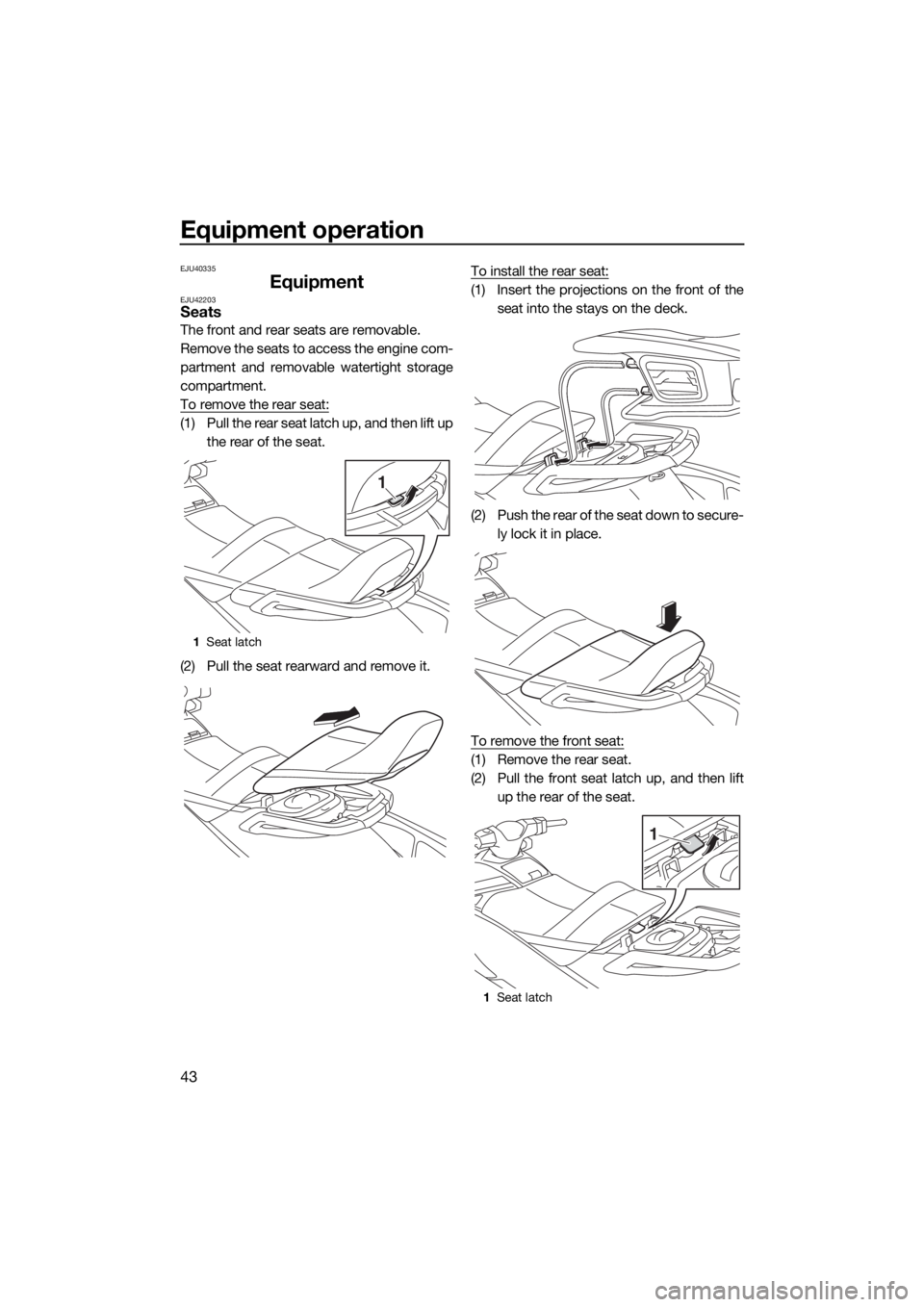
Equipment operation
43
EJU40335
EquipmentEJU42203Seats
The front and rear seats are removable.
Remove the seats to access the engine com-
partment and removable watertight storage
compartment.
To remove the rear seat:
(1) Pull the rear seat latch up, and then lift up
the rear of the seat.
(2) Pull the seat rearward and remove it.To install the rear seat:
(1) Insert the projections on the front of the
seat into the stays on the deck.
(2) Push the rear of the seat down to secure-
ly lock it in place.
To remove the front seat:
(1) Remove the rear seat.
(2) Pull the front seat latch up, and then lift
up the rear of the seat.
1Seat latch
1
1Seat latch
1
UF4G74E0.book Page 43 Tuesday, July 16, 2019 10:27 AM
Page 58 of 110
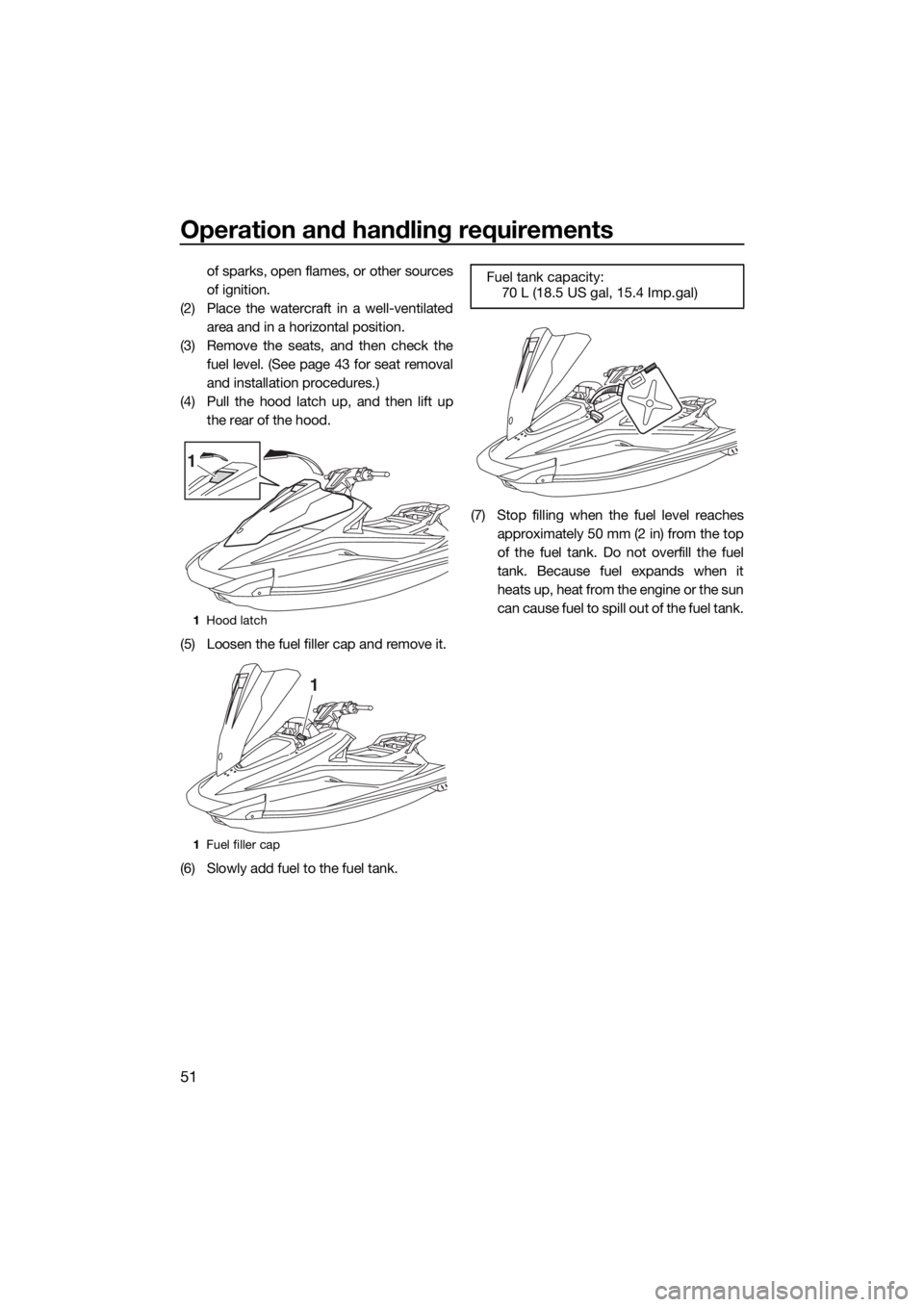
Operation and handling requirements
51
of sparks, open flames, or other sources
of ignition.
(2) Place the watercraft in a well-ventilated
area and in a horizontal position.
(3) Remove the seats, and then check the
fuel level. (See page 43 for seat removal
and installation procedures.)
(4) Pull the hood latch up, and then lift up
the rear of the hood.
(5) Loosen the fuel filler cap and remove it.
(6) Slowly add fuel to the fuel tank.(7) Stop filling when the fuel level reaches
approximately 50 mm (2 in) from the top
of the fuel tank. Do not overfill the fuel
tank. Because fuel expands when it
heats up, heat from the engine or the sun
can cause fuel to spill out of the fuel tank.
1Hood latch
1Fuel filler cap
1
1
Fuel tank capacity:
70 L (18.5 US gal, 15.4 Imp.gal)
UF4G74E0.book Page 51 Tuesday, July 16, 2019 10:27 AM
Page 60 of 110
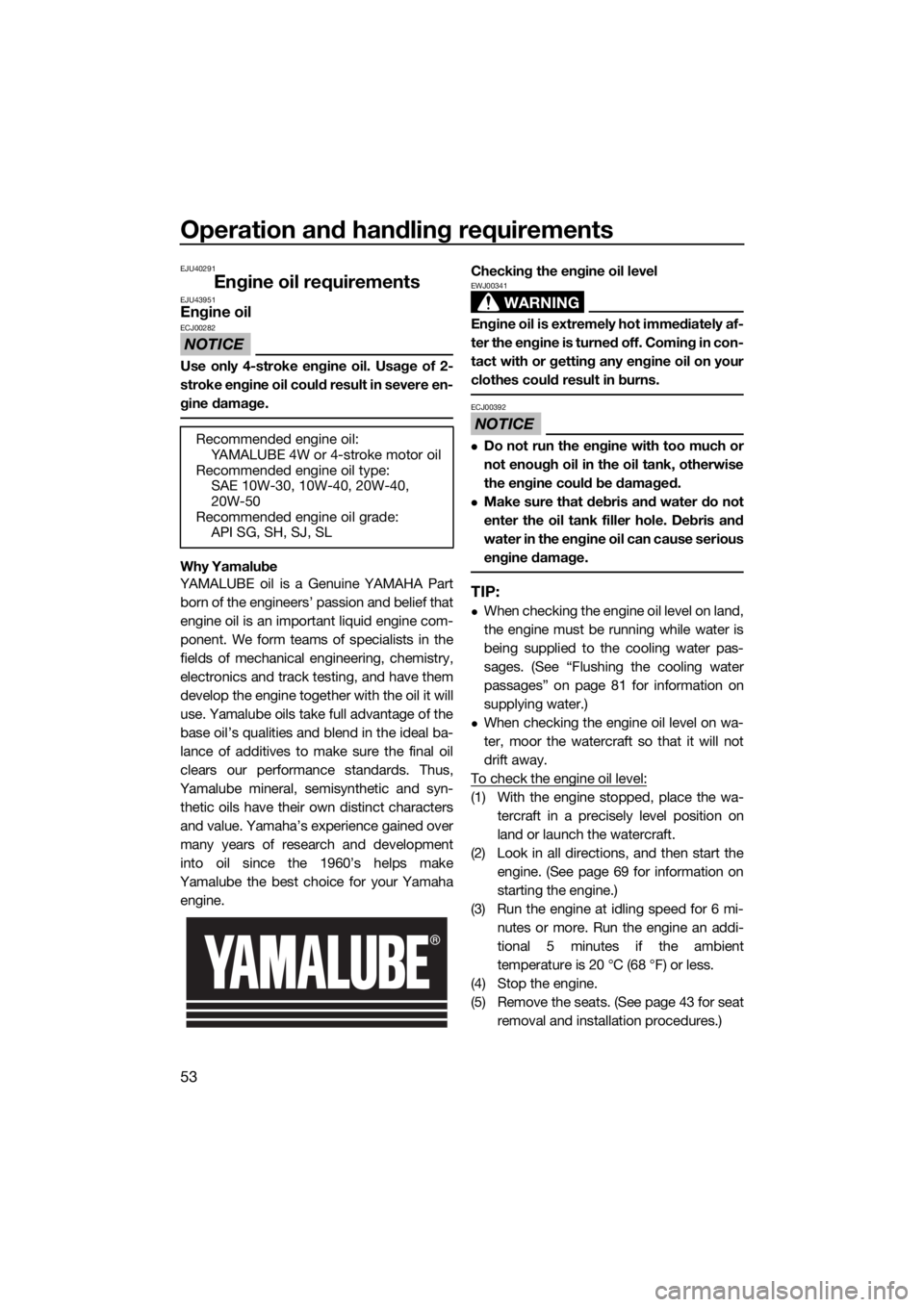
Operation and handling requirements
53
EJU40291
Engine oil requirementsEJU43951Engine oil
NOTICE
ECJ00282
Use only 4-stroke engine oil. Usage of 2-
stroke engine oil could result in severe en-
gine damage.
Why Yamalube
YAMALUBE oil is a Genuine YAMAHA Part
born of the engineers’ passion and belief that
engine oil is an important liquid engine com-
ponent. We form teams of specialists in the
fields of mechanical engineering, chemistry,
electronics and track testing, and have them
develop the engine together with the oil it will
use. Yamalube oils take full advantage of the
base oil’s qualities and blend in the ideal ba-
lance of additives to make sure the final oil
clears our performance standards. Thus,
Yamalube mineral, semisynthetic and syn-
thetic oils have their own distinct characters
and value. Yamaha’s experience gained over
many years of research and development
into oil since the 1960’s helps make
Yamalube the best choice for your Yamaha
engine.Checking the engine oil level
WARNING
EWJ00341
Engine oil is extremely hot immediately af-
ter the engine is turned off. Coming in con-
tact with or getting any engine oil on your
clothes could result in burns.
NOTICE
ECJ00392
Do not run the engine with too much or
not enough oil in the oil tank, otherwise
the engine could be damaged.
Make sure that debris and water do not
enter the oil tank filler hole. Debris and
water in the engine oil can cause serious
engine damage.
TIP:
When checking the engine oil level on land,
the engine must be running while water is
being supplied to the cooling water pas-
sages. (See “Flushing the cooling water
passages” on page 81 for information on
supplying water.)
When checking the engine oil level on wa-
ter, moor the watercraft so that it will not
drift away.
To check the engine oil level:
(1) With the engine stopped, place the wa-
tercraft in a precisely level position on
land or launch the watercraft.
(2) Look in all directions, and then start the
engine. (See page 69 for information on
starting the engine.)
(3) Run the engine at idling speed for 6 mi-
nutes or more. Run the engine an addi-
tional 5 minutes if the ambient
temperature is 20 °C (68 °F) or less.
(4) Stop the engine.
(5) Remove the seats. (See page 43 for seat
removal and installation procedures.) Recommended engine oil:
YAMALUBE 4W or 4-stroke motor oil
Recommended engine oil type:
SAE 10W-30, 10W-40, 20W-40,
20W-50
Recommended engine oil grade:
API SG, SH, SJ, SL
UF4G74E0.book Page 53 Tuesday, July 16, 2019 10:27 AM
Page 61 of 110
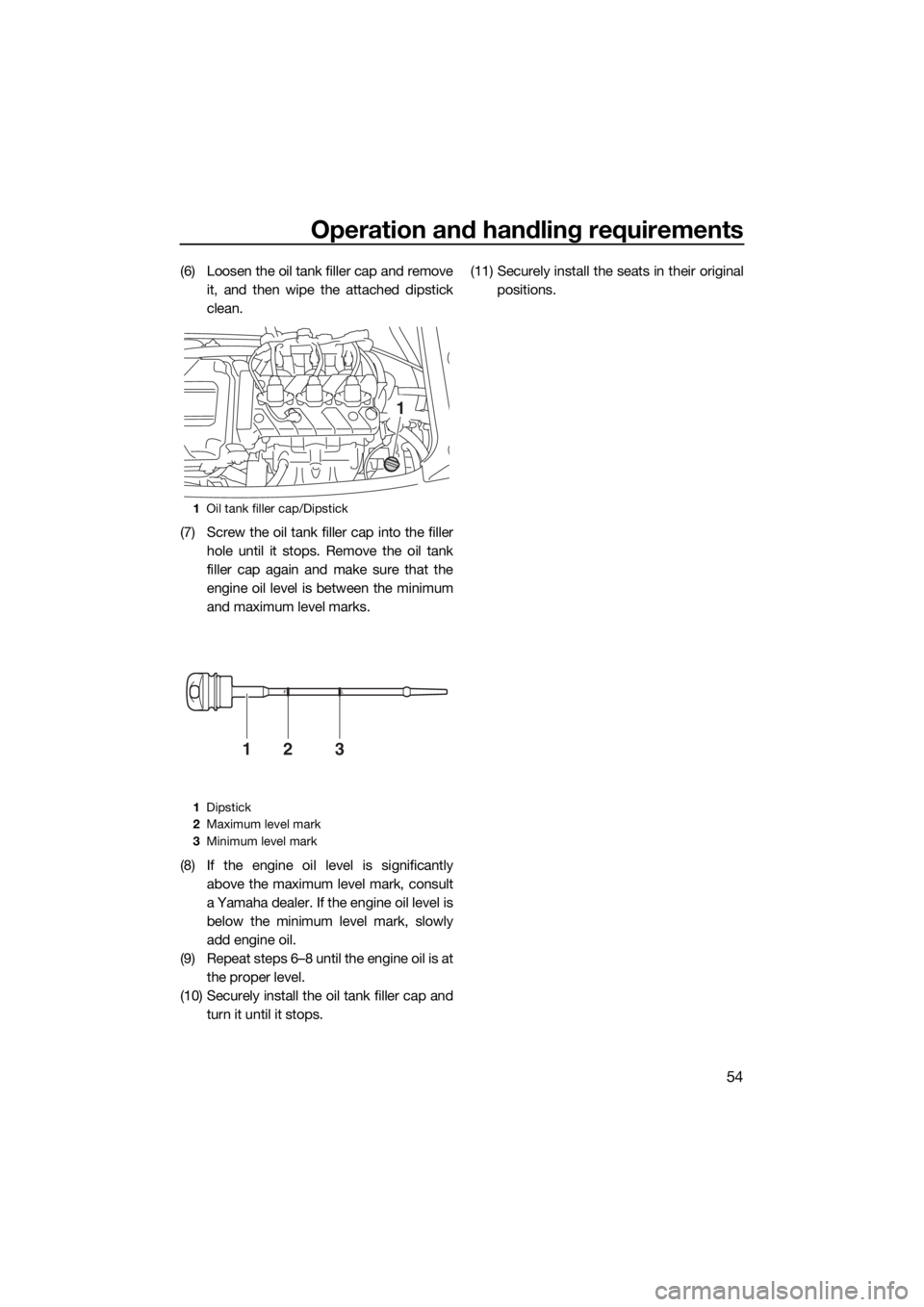
Operation and handling requirements
54
(6) Loosen the oil tank filler cap and remove
it, and then wipe the attached dipstick
clean.
(7) Screw the oil tank filler cap into the filler
hole until it stops. Remove the oil tank
filler cap again and make sure that the
engine oil level is between the minimum
and maximum level marks.
(8) If the engine oil level is significantly
above the maximum level mark, consult
a Yamaha dealer. If the engine oil level is
below the minimum level mark, slowly
add engine oil.
(9) Repeat steps 6–8 until the engine oil is at
the proper level.
(10) Securely install the oil tank filler cap and
turn it until it stops.(11) Securely install the seats in their original
positions.
1Oil tank filler cap/Dipstick
1Dipstick
2Maximum level mark
3Minimum level mark
1
213
UF4G74E0.book Page 54 Tuesday, July 16, 2019 10:27 AM
Page 67 of 110

Pre-operation checks
60
EJU32282
Pre-operation check pointsEJU42384Pre-launch checks
Perform the pre-launch checks in the pre-op-
eration checklist while the watercraft is on
land.
To perform the pre-launch checks:
(1) Remove the seats and removable water-
tight storage compartment. (See page 43
for seat removal and installation proce-
dures and page 48 for information on the
removable watertight storage compart-
ment.)
(2) Perform the checks and make sure that
there are no malfunctioning items or oth-
er problems.
(3) After completing these checks, securely
install the removable watertight storage
compartment and seats in their original
positions.
EJU32334Engine compartment check
WARNING
EWJ00462
Failure to ventilate the engine compart-
ment could result in a fire or explosion. Do
not start the engine if there is a fuel leak.
Ventilate the engine compartment. Leave the
engine compartment open for a few minutes
to allow any fuel vapors to escape.Make sure that there is no damage inside the
engine compartment.
EJU34215Fuel system checks
WARNING
EWJ00382
Leaking fuel can result in fire or explosion.
Check for fuel leakage regularly.
If any fuel leakage is found, the fuel sys-
tem must be repaired by a qualified me-
chanic. Improper repairs can make the
watercraft unsafe to operate.
Make sure that there is no damage, leakage,
or other problem in the fuel system.
Check:
Fuel filler cap and seal for damage
Fuel tank for damage and leakage
Fuel hoses and joints for damage and leak-
age
Fuel tank breather hose for damage and
leakage
EJU36875Fuel level check
Check the fuel level in the fuel tank.
Add fuel if necessary. (See page 50 for infor-
mation on filling the fuel tank.)
UF4G74E0.book Page 60 Tuesday, July 16, 2019 10:27 AM
Page 88 of 110
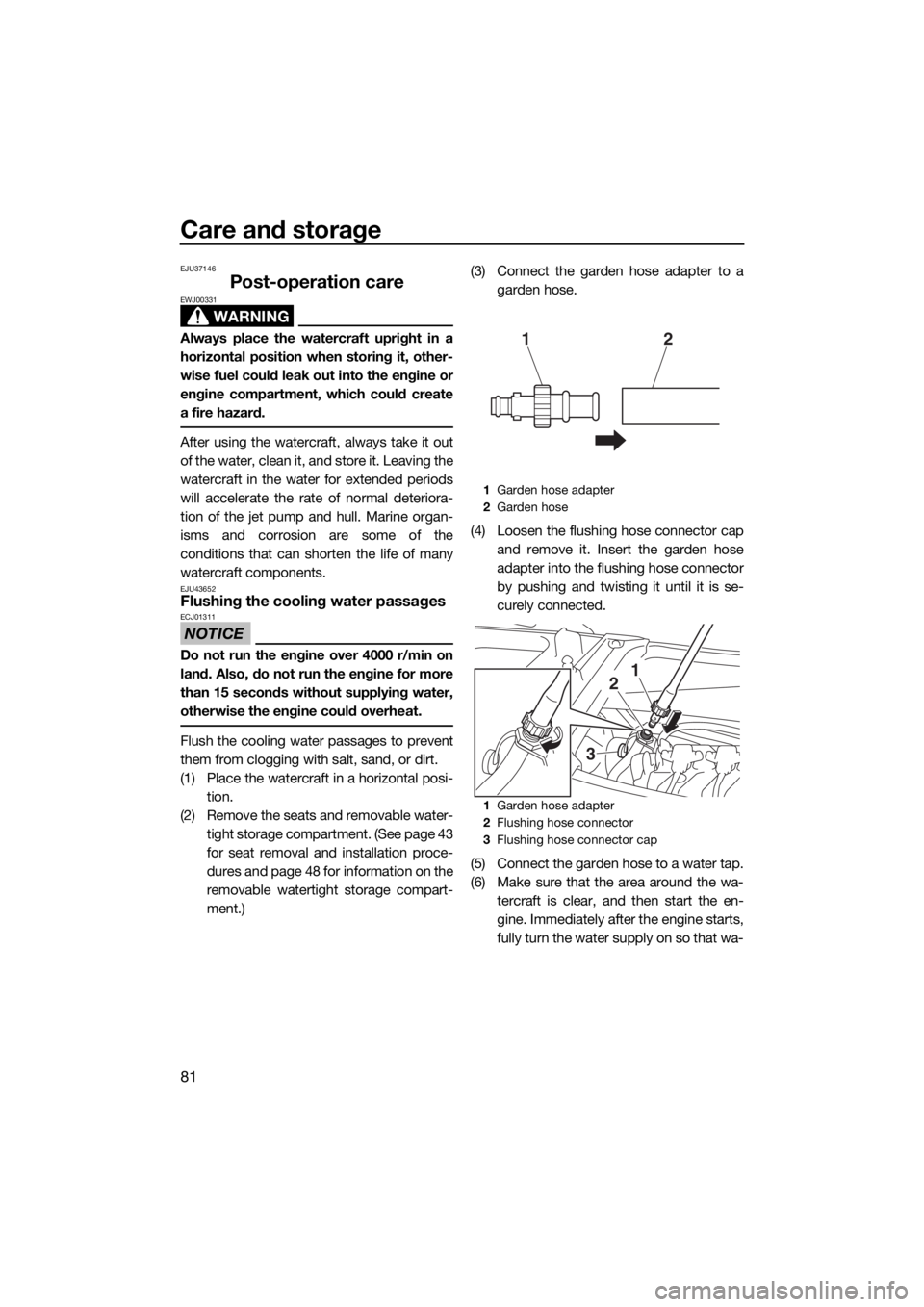
Care and storage
81
EJU37146
Post-operation care
WARNING
EWJ00331
Always place the watercraft upright in a
horizontal position when storing it, other-
wise fuel could leak out into the engine or
engine compartment, which could create
a fire hazard.
After using the watercraft, always take it out
of the water, clean it, and store it. Leaving the
watercraft in the water for extended periods
will accelerate the rate of normal deteriora-
tion of the jet pump and hull. Marine organ-
isms and corrosion are some of the
conditions that can shorten the life of many
watercraft components.
EJU43652Flushing the cooling water passages
NOTICE
ECJ01311
Do not run the engine over 4000 r/min on
land. Also, do not run the engine for more
than 15 seconds without supplying water,
otherwise the engine could overheat.
Flush the cooling water passages to prevent
them from clogging with salt, sand, or dirt.
(1) Place the watercraft in a horizontal posi-
tion.
(2) Remove the seats and removable water-
tight storage compartment. (See page 43
for seat removal and installation proce-
dures and page 48 for information on the
removable watertight storage compart-
ment.)(3) Connect the garden hose adapter to a
garden hose.
(4) Loosen the flushing hose connector cap
and remove it. Insert the garden hose
adapter into the flushing hose connector
by pushing and twisting it until it is se-
curely connected.
(5) Connect the garden hose to a water tap.
(6) Make sure that the area around the wa-
tercraft is clear, and then start the en-
gine. Immediately after the engine starts,
fully turn the water supply on so that wa-
1Garden hose adapter
2Garden hose
1Garden hose adapter
2Flushing hose connector
3Flushing hose connector cap
12
12
3
UF4G74E0.book Page 81 Tuesday, July 16, 2019 10:27 AM
Page 89 of 110
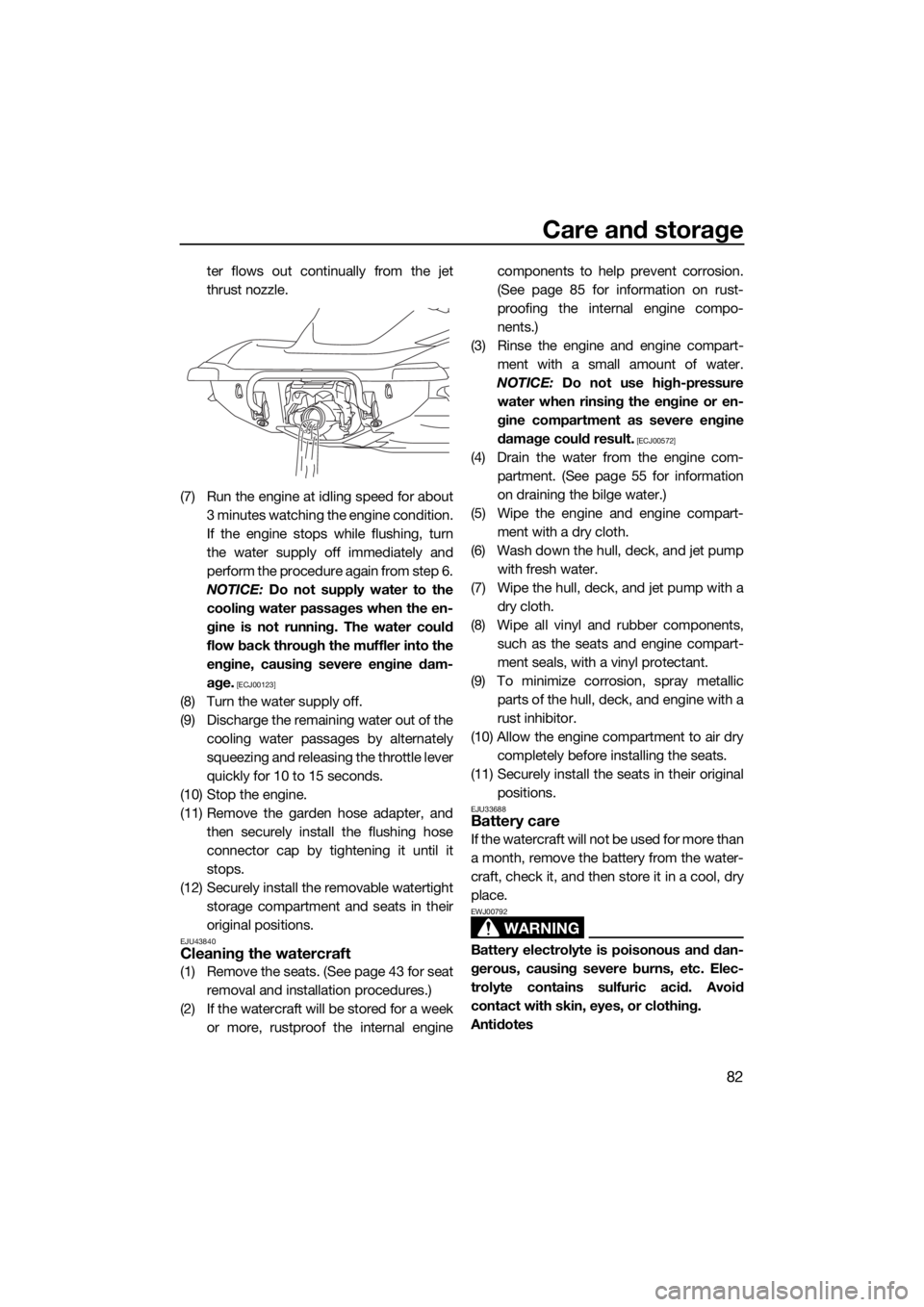
Care and storage
82
ter flows out continually from the jet
thrust nozzle.
(7) Run the engine at idling speed for about
3 minutes watching the engine condition.
If the engine stops while flushing, turn
the water supply off immediately and
perform the procedure again from step 6.
NOTICE: Do not supply water to the
cooling water passages when the en-
gine is not running. The water could
flow back through the muffler into the
engine, causing severe engine dam-
age.
[ECJ00123]
(8) Turn the water supply off.
(9) Discharge the remaining water out of the
cooling water passages by alternately
squeezing and releasing the throttle lever
quickly for 10 to 15 seconds.
(10) Stop the engine.
(11) Remove the garden hose adapter, and
then securely install the flushing hose
connector cap by tightening it until it
stops.
(12) Securely install the removable watertight
storage compartment and seats in their
original positions.
EJU43840Cleaning the watercraft
(1) Remove the seats. (See page 43 for seat
removal and installation procedures.)
(2) If the watercraft will be stored for a week
or more, rustproof the internal enginecomponents to help prevent corrosion.
(See page 85 for information on rust-
proofing the internal engine compo-
nents.)
(3) Rinse the engine and engine compart-
ment with a small amount of water.
NOTICE: Do not use high-pressure
water when rinsing the engine or en-
gine compartment as severe engine
damage could result.
[ECJ00572]
(4) Drain the water from the engine com-
partment. (See page 55 for information
on draining the bilge water.)
(5) Wipe the engine and engine compart-
ment with a dry cloth.
(6) Wash down the hull, deck, and jet pump
with fresh water.
(7) Wipe the hull, deck, and jet pump with a
dry cloth.
(8) Wipe all vinyl and rubber components,
such as the seats and engine compart-
ment seals, with a vinyl protectant.
(9) To minimize corrosion, spray metallic
parts of the hull, deck, and engine with a
rust inhibitor.
(10) Allow the engine compartment to air dry
completely before installing the seats.
(11) Securely install the seats in their original
positions.
EJU33688Battery care
If the watercraft will not be used for more than
a month, remove the battery from the water-
craft, check it, and then store it in a cool, dry
place.
WARNING
EWJ00792
Battery electrolyte is poisonous and dan-
gerous, causing severe burns, etc. Elec-
trolyte contains sulfuric acid. Avoid
contact with skin, eyes, or clothing.
Antidotes
UF4G74E0.book Page 82 Tuesday, July 16, 2019 10:27 AM
Page 92 of 110
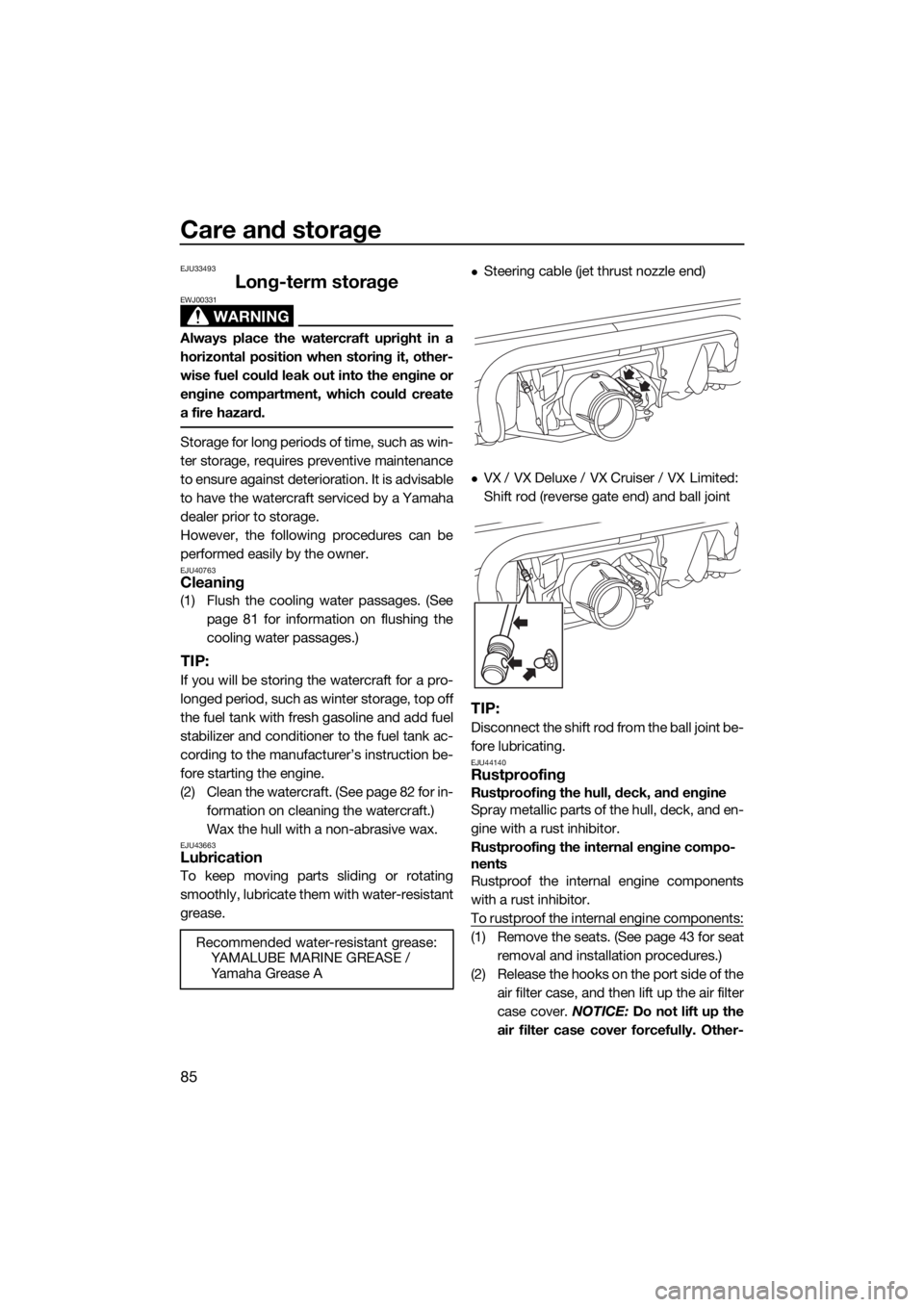
Care and storage
85
EJU33493
Long-term storage
WARNING
EWJ00331
Always place the watercraft upright in a
horizontal position when storing it, other-
wise fuel could leak out into the engine or
engine compartment, which could create
a fire hazard.
Storage for long periods of time, such as win-
ter storage, requires preventive maintenance
to ensure against deterioration. It is advisable
to have the watercraft serviced by a Yamaha
dealer prior to storage.
However, the following procedures can be
performed easily by the owner.
EJU40763Cleaning
(1) Flush the cooling water passages. (See
page 81 for information on flushing the
cooling water passages.)
TIP:
If you will be storing the watercraft for a pro-
longed period, such as winter storage, top off
the fuel tank with fresh gasoline and add fuel
stabilizer and conditioner to the fuel tank ac-
cording to the manufacturer’s instruction be-
fore starting the engine.
(2) Clean the watercraft. (See page 82 for in-
formation on cleaning the watercraft.)
Wax the hull with a non-abrasive wax.
EJU43663Lubrication
To keep moving parts sliding or rotating
smoothly, lubricate them with water-resistant
grease.
Steering cable (jet thrust nozzle end)
VX / VX Deluxe / VX Cruiser / VX Limited:
Shift rod (reverse gate end) and ball joint
TIP:
Disconnect the shift rod from the ball joint be-
fore lubricating.
EJU44140Rustproofing
Rustproofing the hull, deck, and engine
Spray metallic parts of the hull, deck, and en-
gine with a rust inhibitor.
Rustproofing the internal engine compo-
nents
Rustproof the internal engine components
with a rust inhibitor.
To rustproof the internal engine components:
(1) Remove the seats. (See page 43 for seat
removal and installation procedures.)
(2) Release the hooks on the port side of the
air filter case, and then lift up the air filter
case cover. NOTICE: Do not lift up the
air filter case cover forcefully. Other- Recommended water-resistant grease:
YAMALUBE MARINE GREASE /
Ya m a h a G r e a s e A
UF4G74E0.book Page 85 Tuesday, July 16, 2019 10:27 AM